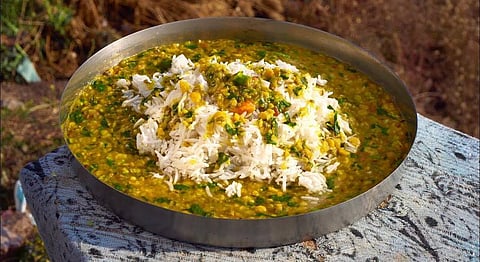
- HOMEGROWN WORLD
- #HGCREATORS
- #HGEXPLORE
- #HGVOICES
- #HGSHOP
- CAREERS
- ABOUT US
- CONTACT US

If there is one combination that incarnates nostalgia and homesickness for Indians, it has to be our dal bhat. When translated the combination refers to ‘dal’, denoting a split pulse, but may also include all dried beans and lentils, paired with ‘bhat’, which is boiled or steamed rice.
Best eaten with hands and occasionally paired with a side of Tarkari (vegetable curry), spicy chutneys, achaars (pickles), this combination which makes the typical Indian diet surprisingly did not originate in India.
While dals were on the Indian menu even before rice and wheat arrived in India – dal recipes originating as back in time as the pre-Harappa period – the hearty combination of pairing dal with bhat is a gift to the world from Nepal’s misty Himalayas. With over 100 diverse ethnic groups, Nepali cuisine is deeply rooted in the culture and the environment of Nepali people.
Since dal bhat is nutritious and affordable, it is the only meal served in food stalls around the Everest base camps. In fact, climbers often refer to each day’s trek by the number of servings of dal bhat needed to complete it, such as – it’s a ‘two dal bhat climb’.
In India, dal, independent of rice, was served as a celebratory meal to guests. The belief goes that ghugni, made from a distinct kind of chana dal cooked with spicy gravy, was prepared on the occasion of Chandragupta Maurya marrying Greek Princess Helen of Troy in 303 BC. Today ghugni is popular breakfast street food, especially in East India.
Another instance is of the Panchratna Dal or Panchmel Dal made up of a mixture of five lentils – moong dal, chana dal, toor dal, masoor dal and urad dal. It was introduced to the predominantly non-vegetarian Mughal kitchen by Jodha Bai upon her marriage to Mughal emperor Akbar.
Dating back to the Mahabharata, it is believed that it was one of the Pandavas, Bhim, who gave a name to this blend and called it ‘Panchratna’ (five gems). The origination, however, remains unknown. On the one hand, it is believed that Draupadi would prepare the dal to compensate for royal standards of nutrition for the Pandavas during their exile and on the other, East India thinks that it was Bhim who invented Panchratna Dal by boiling five dals in a pot topped with ghee.
As far as the stories go, what they all have in common is the comfort that this combination brings – of home and a bowl of spicy tempered dal with steamed rice.
If you enjoyed reading this, we also suggest:
